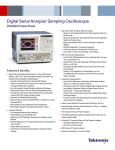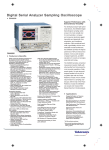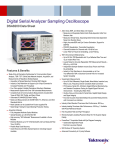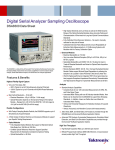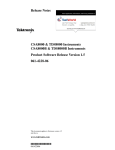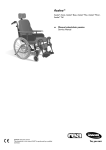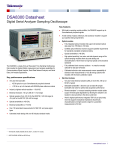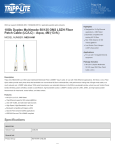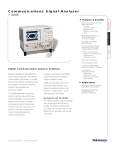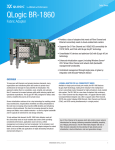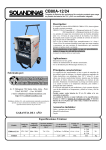Download 80C04 User Manual
Transcript
xx ZZZ 80C00 Series Optical Sampling Modules User Manual *P071043512* 071-0435-12 xx ZZZ 80C00 Series Optical Sampling Modules User Manual www.tektronix.com 071-0435-12 Copyright © Tektronix. All rights reserved. Licensed software products are owned by Tektronix or its subsidiaries or suppliers, and are protected by national copyright laws and international treaty provisions. Tektronix products are covered by U.S. and foreign patents, issued and pending. Information in this publication supersedes that in all previously published material. Specifications and price change privileges reserved. TEKTRONIX and TEK are registered trademarks of Tektronix, Inc. Contacting Tektronix Tektronix, Inc. 14150 SW Karl Braun Drive P.O. Box 500 Beaverton, OR 97077 USA For product information, sales, service, and technical support: In North America, call 1-800-833-9200. Worldwide, visit www.tektronix.com to find contacts in your area. Warranty Tektronix warrants that this product will be free from defects in materials and workmanship for a period of one (1) year from the date of shipment. If any such product proves defective during this warranty period, Tektronix, at its option, either will repair the defective product without charge for parts and labor, or will provide a replacement in exchange for the defective product. Parts, modules and replacement products used by Tektronix for warranty work may be new or reconditioned to like new performance. All replaced parts, modules and products become the property of Tektronix. In order to obtain service under this warranty, Customer must notify Tektronix of the defect before the expiration of the warranty period and make suitable arrangements for the performance of service. Customer shall be responsible for packaging and shipping the defective product to the service center designated by Tektronix, with shipping charges prepaid. Tektronix shall pay for the return of the product to Customer if the shipment is to a location within the country in which the Tektronix service center is located. Customer shall be responsible for paying all shipping charges, duties, taxes, and any other charges for products returned to any other locations. This warranty shall not apply to any defect, failure or damage caused by improper use or improper or inadequate maintenance and care. Tektronix shall not be obligated to furnish service under this warranty a) to repair damage resulting from attempts by personnel other than Tektronix representatives to install, repair or service the product; b) to repair damage resulting from improper use or connection to incompatible equipment; c) to repair any damage or malfunction caused by the use of non-Tektronix supplies; or d) to service a product that has been modified or integrated with other products when the effect of such modification or integration increases the time or difficulty of servicing the product. THIS WARRANTY IS GIVEN BY TEKTRONIX WITH RESPECT TO THE PRODUCT IN LIEU OF ANY OTHER WARRANTIES, EXPRESS OR IMPLIED. TEKTRONIX AND ITS VENDORS DISCLAIM ANY IMPLIED WARRANTIES OF MERCHANTABILITY OR FITNESS FOR A PARTICULAR PURPOSE. TEKTRONIX’ RESPONSIBILITY TO REPAIR OR REPLACE DEFECTIVE PRODUCTS IS THE SOLE AND EXCLUSIVE REMEDY PROVIDED TO THE CUSTOMER FOR BREACH OF THIS WARRANTY. TEKTRONIX AND ITS VENDORS WILL NOT BE LIABLE FOR ANY INDIRECT, SPECIAL, INCIDENTAL, OR CONSEQUENTIAL DAMAGES IRRESPECTIVE OF WHETHER TEKTRONIX OR THE VENDOR HAS ADVANCE NOTICE OF THE POSSIBILITY OF SUCH DAMAGES. [W2 – 15AUG04] Table of Contents General Safety Summary ......................................................................................... Environmental Considerations ................................................................................... Preface ............................................................................................................. Specifications................................................................................................. Manual Structure............................................................................................. Related Documentation ..................................................................................... Getting Started ...................................................................................................... Product Description............................................................................................ Options and Accessories ...................................................................................... Installation ...................................................................................................... Operating Basics................................................................................................... Usage........................................................................................................... System Interaction ............................................................................................ Front Panel Controls.......................................................................................... Commands From the Main Instrument Front Panel....................................................... Programmer Interface Commands .......................................................................... User Adjustments ............................................................................................. Optimizing Measurement Accuracy ........................................................................ Cleaning ....................................................................................................... Reference ........................................................................................................... Wavelength, Filter, and Bandwidth Selection ............................................................. Clock and Data Recovery .................................................................................... Optical Bandwidth ............................................................................................ Extinction Ratio Calibration ................................................................................. Glossary Index 80C00 Series Optical Sampling Modules User Manual iv vi vii vii viii viii 1 1 6 9 13 13 15 16 19 21 21 21 27 29 29 31 32 33 i Table of Contents List of Figures Figure 1: Figure 2: Figure 3: Figure 4: Figure 5: Figure 6: ii Module compartments.................................................................................. Installing a large module .............................................................................. Connecting optical cables correctly.................................................................. Incorrectly connecting optical cables ................................................................ Typical Optical module front panels, 80C01-CR and 80C12-10G shown....................... System Vertical menu ................................................................................. 9 11 14 14 17 20 80C00 Series Optical Sampling Modules User Manual Table of Contents List of Tables Table 1: Application software version required ................................................................. 1 Table 2: Optical module features (80C02)....................................................................... 2 Table 3: Optical module features (80C07B, 80C08C, and 80C12) ........................................... 3 Table 4: Optical module features (80C10, 80C10B, 80C11, and 80C25GBE) .............................. 4 Table 5: Available options ......................................................................................... 6 Table 6: Standard accessories ..................................................................................... 7 Table 7: Optional accessories ..................................................................................... 8 Table 8: Maximum optical signal levels ........................................................................ 15 Table 9: Clock recovery outputs ................................................................................. 18 Table 10: Wavelength, Filter, and Bandwidth selections...................................................... 29 80C00 Series Optical Sampling Modules User Manual iii General Safety Summary General Safety Summary Review the following safety precautions to avoid injury and prevent damage to this product or any products connected to it. To avoid potential hazards, use this product only as specified. Only qualified personnel should perform service procedures. While using this product, you may need to access other parts of a larger system. Read the safety sections of the other component manuals for warnings and cautions related to operating the system. To Avoid Fire or Personal Injury Ground the product. This product is indirectly grounded through the grounding conductor of the mainframe power cord. To avoid electric shock, the grounding conductor must be connected to earth ground. Before making connections to the input or output terminals of the product, ensure that the product is properly grounded. Observe all terminal ratings. To avoid fire or shock hazard, observe all ratings and markings on the product. Consult the product manual for further ratings information before making connections to the product. The inputs are not rated for connection to mains or Category II, III, or IV circuits. Do not apply a potential to any terminal, including the common terminal, that exceeds the maximum rating of that terminal. Do not operate without covers. Do not operate this product with covers or panels removed. Do not operate with suspected failures. If you suspect that there is damage to this product, have it inspected by qualified service personnel. Avoid exposed circuitry. Do not touch exposed connections and components when power is present. Wear eye protection. Wear eye protection if exposure to high-intensity rays or laser radiation exists. Do not operate in wet/damp conditions. Do not operate in an explosive atmosphere. Keep product surfaces clean and dry. Provide proper ventilation. Refer to the manual’s installation instructions for details on installing the product so it has proper ventilation. iv 80C00 Series Optical Sampling Modules User Manual General Safety Summary Terms in This Manual These terms may appear in this manual: WARNING. Warning statements identify conditions or practices that could result in injury or loss of life. CAUTION. Caution statements identify conditions or practices that could result in damage to this product or other property. Symbols and Terms on the Product These terms may appear on the product: DANGER indicates an injury hazard immediately accessible as you read the marking. WARNING indicates an injury hazard not immediately accessible as you read the marking. CAUTION indicates a hazard to property including the product. The following symbol(s) may appear on the product: 80C00 Series Optical Sampling Modules User Manual v Environmental Considerations Environmental Considerations This section provides information about the environmental impact of the product. Product End-of-Life Handling Observe the following guidelines when recycling an instrument or component: Equipment Recycling. Production of this equipment required the extraction and use of natural resources. The equipment may contain substances that could be harmful to the environment or human health if improperly handled at the product’s end of life. In order to avoid release of such substances into the environment and to reduce the use of natural resources, we encourage you to recycle this product in an appropriate system that will ensure that most of the materials are reused or recycled appropriately. This symbol indicates that this product complies with the applicable European Union requirements according to Directives 2002/96/EC and 2006/66/EC on waste electrical and electronic equipment (WEEE) and batteries. For information about recycling options, check the Support/Service section of the Tektronix Web site (www.tektronix.com). Restriction of Hazardous Substances vi This product has been classified as Monitoring and Control equipment, and is outside the scope of the 2002/95/EC RoHS Directive. 80C00 Series Optical Sampling Modules User Manual Preface This is the user manual for the 80C00 Series Optical Modules and their available options. It includes the following information: Describes the capabilities of the modules and how to install them Explains how to operate the modules: how to control acquisition, processing, and input/output of information Go to the Tektronix Web site at http://www.tek.com for the latest revision of the user documentation. Enter the part number or product name to locate, and the download type, in the Downloads fields on the home page and click GO. You can also order a printed version of this manual. (See page 8, Optional Accessories.) Specifications Specifications are located in the DSA8200 Digital Serial Analyzer Specifications and Performance Verification Technical Reference (Tektronix part number 071-2048-xx). You can download the manual from the Tektronix Web site (www.tektronix.com). To meet measurement specifications, the following instrument conditions must be met: The instrument must have been calibrated/adjusted at an ambient temperature between +20 °C and +30 °C. The instrument must have been operating continuously for 20 minutes within the operating temperature range specified. Vertical compensation must have been performed with the module installed in the same compartment used when the compensation was performed. Ambient temperature must be within ± 2 °C of the compensation temperature. The instrument must be in an environment with temperature, altitude, humidity, and vibration within the operating limits described in the specifications. 80C00 Series Optical Sampling Modules User Manual vii Preface Manual Structure This manual is composed of the following chapters: Getting Started shows you how to configure and install your optical module. Operating Basics describes controlling the module using the front panel and the instrument user interface. Reference provides information on wavelength selection, clock recovery, and optical bandwidth. Related Documentation This document covers installation and usage of the sampling module and its features. For information about the main instrument in which the sampling module is installed, refer to the user documents and online help provided with your main instrument. viii 80C00 Series Optical Sampling Modules User Manual Getting Started The 80C00 Series Optical Modules and their available options are high-performance optical modules that support high bandwidth telecom and datacom standards. The 80C00 Series modules work with the following main instruments (mainframes): DSA8200 Digital Serial Analyzer CSA8000, CSA8000B, and CSA8200 Communications Signal Analyzers TDS8000, TDS8000B, and TDS8200 Digital Sampling Oscilloscopes Proper operation of the optical sampling modules requires that the appropriate application software is installed on the main instrument. The following table lists the mainframe application software versions and the optical modules supported. To display the version installed, select About from the Help menu of the main instrument. Table 1: Application software version required Application software version Modules supported 1.0 1 80C01, 80C01-CR, 80C02, 80C02-CR 1.4 1 Added: 80C10 1.5 1 Added: 80C07B, 80C07B-CR1 80C08C, 80C08C-CR1, 80C08C-CR2, 80C08C-CR4, 80C11, 80C11-CR1, 80C11-CR2, 80C11-CR3, 80C11-CR4 2.0.1.3 2, 3 Added: 80C12 (limited) 2.0.1.5 3 Added: 80C12 5.0 or greater 1 2 3 4 4 Added: 80C02 Option 01, 80C08C Option 01, 80C10B, 80C11 Option 01, 80C12 Option 01, 80C25GBE Product application software version 1.x requires the Windows 98 operating system. Product application software version 2.x requires the Windows 2000 operating system. Product application software version 2.0.1.3 should be replaced with the latest version available for download from the Tektronix Web site. Product application software version 5.x requires the Windows XP operating system. Product Description The optical modules provide the features listed in the following tables: (See Table 3.) (See Table 4.) A table in the Reference section provides wavelength selections, filter and bandwidth specifications for each module. (See Table 10 on page 29.) 80C00 Series Optical Sampling Modules User Manual 1 Getting Started A figure in the Operating Basics section shows the module controls, connectors, and indicators. (See Figure 5 on page 17.) Table 2: Optical module features (80C02) Feature 80C02 1 Number of input channels 1 Effective wavelength range 1100 nm to 1650 nm Supported standards or data filtering rates OC-192/STM-64 Clock recovery, option OC-192/STM-64 Absolute maximum nondestructive optical input 2 5 mW average power; 10 mW peak power at wavelength with highest relative responsivity Internal Fiber Diameter 9 mm/125 μm single mode 3 Optical return loss > 30 dB typical Minimum optical bandwidth at optical connector > 30 GHz Output zero < 10 μW immediately after dark calibration Independent channel deskew Standard Offset capability at front of module Standard Power meter Standard 1 2 3 2 Some values in the table are typical. The optical input powers below nondestructive levels may exceed saturation and compression limits of the module. Compatible with single-mode fiber of equal or smaller diameter. 80C00 Series Optical Sampling Modules User Manual Getting Started Table 3: Optical module features (80C07B, 80C08C, and 80C12) Feature 80C07B 1 80C08C 1 80C12 1 Number of input channels 1 1 1 Effective wavelength range 700 nm to 1650 nm 700 nm to 1650 nm 700 nm to 1650 nm Supported standards or data filtering rates Standard OC-48 / STM-16, 2 Gigabit Ethernet (ENET2500/2GBE), Infiniband Optional 2 OC-3 / STM-1, OC-12 / STM-4, FibreChannel (FC1063/FC), Gigabit Ethernet (ENET1250/GBE), 2G FibreChannel (FC2125/2FC) 9.95328 Gb/s (10GBASE-W), 9.95328 Gb/s (OC-192/STM64), 10.3125 (10GBASE-R), 10.51875 (10GFC), 10.66423 Gb/s (G.975 FEC), 10.709225 Gb/s (G.709 FEC), 11.10 Gb/s (10GbE FEC), 11.317 Gb/s (10GFC FEC) Multi Gigabit Options 3 1.0625 Gb/s (FC1063) 2.125 Gb/s (FC2125) 3.125 Gb/s (10GBase-X4) 3.188 Gb/s (10GFC-X4) 3.318 Gb/s (VSR-5) 4.250 Gb/s (FC4250) 10 Gigabit Option (Option 10G) 9.95328 Gb/s (10GBase-W), 9.95328 Gb/s (OC-192/STM64), 10.3125 Gb/s (10GBase-R), 10.51875 Gb/s (10GFC), 10.66423 Gb/s (G.975 FEC), 10.709225 Gb/s (G.709 FEC), 11.10 Gb/s (10GbE FEC), 11.317 Gb/s (10GFC FEC) Clock recovery option 155.52 Mb/s (OC-3/STM-1), 622.08 Mb/s (OC-12/STM-4), 1062.5 Mb/s (FC1063/FC), 1250 Mb/s (ENET1250/GBE), 2125 Mb/s (FC2125/2FC), 2488.32 Mb/s (OC-48/STM-16), 2500 Mb/s (ENET2500/2GBE), 2500 Mb/s (Infiniband), 2666.06 Mb/s (OC-48-FEC) 9.95328 Gb/s (10GBASE-W/ OC-192/STM-64) (CR-1) 10.3125 Gb/s (10GBASE-R) (CR-1 & CR-2) 10.51875 Gb/s (10GFC) (CR-2 only) Continuous-rate from 9.8 Gb/s to 12.6 Gb/s (CR-4) 4 Clock recovery supported with the use of the 80A05 or 80A07 Electrical Clock Recovery module (purchased separately) 5 mW average power; 10 mW peak power at wavelength with highest relative responsivity 1 mW average power; 10 mW peak power for 60 ms. 1 mW average power; 10 mW peak power for 60 ms. Internal fiber diameter 62.5 mm/125 μm multimode mode 6 62.5 mm/125 μm multimode mode 6 62.5 mm/125 μm multimode mode 6 Optical return loss > 14 dB for multimode fiber > 24 dB for single-mode fiber > 14 dB for multimode fiber > 24 dB for single-mode fiber > 14 dB for multimode fiber > 24 dB for single-mode fiber Minimum optical bandwidth at optical connector > 2.3 GHz > 9.5 GHz > 8.5 GHz > 9.5 GHz with Option 10G Absolute maximum nondestructive optical input 5 80C00 Series Optical Sampling Modules User Manual 3 Getting Started Feature 80C07B 1 80C08C 1 80C12 1 Output zero < 500 nW immediately after dark calibration ±2% (vertical offset) < 1 μW immediately after dark calibration ±2% (vertical offset) < 1 μW immediately after dark calibration ±2% (vertical offset) Independent channel deskew Standard Standard Standard Offset capability at front of module Standard Standard Standard Power meter Standard Standard Standard 1 2 3 4 5 6 Some values in the table are typical. The 80C07B is shipped with five reference receiver filters. Three are standard, with the two remaining configured at the time of purchase. (See Table 5 on page 6.) The 80C12 is available with a variety of options that support 2 to 4 filters. (See Table 5 on page 6.) Continuous-rate clock recovery supporting any standard or user-definable rate in the range from 9.8 Gb/s to 12.6 Gb/s. The optical input powers below nondestructive levels may exceed saturation and compression limits of the module. Compatible with single-mode fiber of equal or smaller diameter. Table 4: Optical module features (80C10, 80C10B, 80C11, and 80C25GBE) Feature 80C10, 80C10B, 80C25GBE 1 2 80C11 1 Number of input channels 1 Effective wavelength range 1310 nm ± 20 nm 1520 nm to 1620 nm 1100 nm to 1650 nm Supported standards or data filtering rates 80C10: 30 GHz 65 GHz 39.813 Gb/s OC768/STM256 43.018 Gb/s G.709 FEC 80C10B: 30 GHz 65 GHz 80 GHz 39.813 Gb/s OC768/STM256 43.018 Gb/s G.709 FEC 41.25 Gb/s 40GBase-FR 80C10B-F1: 65 GHz 39.813 Gb/s OC768/STM256 43.018 Gb/s G.709 FEC 41.25 Gb/s 40GBase-FR 25.781 Gb/s 100GBase-xR4 27.739 Gb/s 100GBase-xR4 FEC 80C25GBE: 65 GHz 25.781 Gb/s 100GBase-xR4 27.739 Gb/s 100GBase-xR4 FEC OC-192/STM-64 (9.953 Gb/s), 10GBASE-W (9.953 Gb/s), 10GBASE-R (10.31 Gb/s), 10GFC (10.518 Gb/s), G.975 FEC (10.66 Gb/s, G.709 FEC (10.71 Gb/s), 10GbE FEC (11.10 Gb/s), 10GFC FEC (11.317 Gb/s) 16GFC (14.025 Gb/s) 4 1 80C00 Series Optical Sampling Modules User Manual Getting Started Table 4: Optical module features (80C10, 80C10B, 80C11, and 80C25GBE) (cont.) Feature 80C10, 80C10B, 80C25GBE 1 80C11 1 Clock recovery option Option CRTP (80C10B, 80C25GBE only) Adds clock recovery data pick-off. Clock recovery provided by the Tektronix CR286A Option HS or other compatible external clock recovery device. Electrical signal output characteristics: 50 Ω, AC coupled, differential 2.92 mm female connectors, maximum 1 ps differential skew 9.95328 Gb/s (10GBASE-W/ OC-192/STM-64) (CR-1, CR2, & CR-3) 10.66423 Gb/s (CR-2) 10.70922 Gb/s (CR-3) Continuous-rate from 9.8 Gb/s to 12.6 Gb/s (CR-4) 3 Absolute maximum nondestructive optical input 4 20 mW average power; 60 mW peak power at wavelength with highest relative responsivity 5 mW average power; 10 mW peak power at wavelength with highest relative responsivity Internal fiber diameter 9 mm/125 μm single mode Optical return loss > 30 dB Minimum optical bandwidth 80C10 > 60 GHz, minimum > 65 GHz, typical 80C10B > 75 GHz, minimum > 80 GHz, typical 80C10B-F1 and 80C25GBE > 60 GHz, minimum > 65 GHz, typical > 30 GHz Output zero 1550 nm: ± [ 25 μW + 4% |Vertical Offset| ] 1310 nm: ± [ 35 μW + 4% |Vertical Offset| ] Up to 14.025 Gb/s settings: < 10 μW ± 2% (vertical offset) 20 GHz, 30 GHz settings: < 10 μW ± 4% (vertical offset) Independent channel deskew Standard Offset capability at front of module Standard Power meter Standard 1 2 3 4 5 5 Some values in the table are typical. The 80C10, 80C10B, and 80C25GBE have two separate optical inputs, one for 1310 nm and one for 1550 nm. Continuous-rate clock recovery supporting any standard or user-definable rate in the range from 9.8 Gb/s to 12.6 Gb/s. The optical input powers below nondestructive levels may exceed saturation and compression limits of the module. Compatible with single-mode fiber of equal or smaller diameter. 80C00 Series Optical Sampling Modules User Manual 5 Getting Started Options and Accessories This section lists the standard and optional accessories available for the sampling modules. Options The following table lists available sampling module options: Table 5: Available options Module Option Description 80C02 Option CR Adds 9.95328 Gb/s clock recovery Option 01 Adds Extinction Ratio calibration Option CR1 Adds 155/622/1063/1250/2125/2488/2500/2666 Mb/s clock recovery Option F1 Adds reference receiver filters OC-3 (155 Mb/s) and OC-12 (622 Mb/s) Option F2 Adds reference receiver filters OC-3 (155 Mb/s) and FibreChannel (1063 Mb/s) Option F3 Adds reference receiver filters OC-3 (155 Mb/s) and Gigabit Ethernet (1250 Mb/s) Option F4 Adds reference receiver filters OC-3 (155 Mb/s) and 2G FibreChannel (2125 Mb/s) Option F5 Adds reference receiver filters OC-12 (622 Mb/s) and FibreChannel (1063 Mb/s) Option F6 Adds reference receiver filters OC-12 (622 Mb/s) and Gigabit Ethernet (1250 Mb/s) Option F7 Adds reference receiver filters OC-12 (622 Mb/s) and 2G FibreChannel (2125 Mb/s) Option F8 Adds reference receiver filters FibreChannel (1063 Mb/s) and Gigabit Ethernet (1250 Mb/s) Option F9 Adds reference receiver filters FibreChannel (1063 Mb/s) and 2G FibreChannel (2125 Mb/s) Option F10 Adds reference receiver filters Gigabit Ethernet (1250 Mb/s) and 2G FibreChannel (2125 Mb/s) Option CR1 Adds 9.95328 Gb/s and 10.3125 Gb/s clock recovery Option CR2 Adds 10.3125 Gb/s and 10.51875 Gb/s clock recovery 80C07B 80C08C 80C10B 80C11 6 Option CR4 Adds continuous clock recovery from 9.8 Gb/s to 12.6 Gb/s Option 01 Adds Extinction Ratio calibration Option F1 Adds reference receiver filters OC768/STM256 (39.813 Gb/s), OTU3 G.709 FEC (43.0184 Gb/s), 40GBase-FR (41.25 Gb/s), 100GBase-xR4 (25.781 Gb/s), 100GBase-xR4 w/ FEC (27.739 Gb/s) (removes 80 GHz and 30 GHz bandwidths) Option CRTP Adds electrical signal outputs to 44.5 Gb/s for use with Tektronix CR286A Option HS or other compatible external clock recovery module Option CR1 Adds 9.95328 Gb/s clock recovery Option CR2 Adds 9.95328 Gb/s and 10.66423 Gb/s clock recovery Option CR3 Adds 9.95328 Gb/s and 10.70922 Gb/s clock recovery Option CR4 Adds continuous clock recovery from 9.8 Gb/s to 12.6 Gb/s Option 01 Adds Extinction Ratio calibration 80C00 Series Optical Sampling Modules User Manual Getting Started Module Option Description 80C12 Option F1 Adds reference receiver filters 1G FibreChannel (1.063 Gb/s), 2G FibreChannel (2.125 Gb/s), 4G FibreChannel (4.250 Gb/s) Option F2 Adds reference receiver filters 2G FibreChannel (2.125 Gb/s), 4G FibreChannel (4.250 Gb/s), 9 GHz optical bandwidth Option F3 Adds reference receiver filters 1G FibreChannel (1.0623 Gb/s), 2G FibreChannel (2.125 Gb/s), 9 GHz optical bandwidth Option F4 Adds reference receiver filters 2G FibreChannel (2.125 Gb/s), 10GBase-X4 (3.125 Gb/s), 4G FibreChannel (4.250 Gb/s), 10GFC-X4 (3.188 Gb/s) Option F5 Adds reference receiver filters 10GBase-X4 (3.125 Gb/s), 4G FibreChannel (4.250 Gb/s), 10GFC-X4 (3.188 Gb/s), 9 GHz optical bandwidth Option F6 Adds reference receiver filters 2G FibreChannel (2.125 Gb/s), 10GBase-X4 (3.125 Gb/s), 10GFC-X4 (3.188 Gb/s), 9 GHz optical bandwidth Option FC Adds reference receiver filters 10GBase-X4 (3.125 Gb/s), VSR-5 (3.318Gb/s), 10GFC-X4 (3.188 Gb/s), 9 GHz optical bandwidth Option 10G Adds reference receiver filters OC192/STM-64 (9.953 Gb/s), 10GFC (10.518 Gb/s), 10GBase-W (9.953 Gb/s), 10GBase-R (10.31 Gb/s), G.975 FEC (10.66 Gb/s), G.709 FEC (10.709 Gb/s), 10GBE FEC (11.10 Gb/s), 10GFC FEC (11.317 Gb/s), 10 GHz optical bandwidth Option 01 Adds Extinction Ratio calibration Option F1 Adds reference receiver filters OC768/STM256 (39.813 Gb/s), OTU3 G.709 FEC (43.0184 Gb/s), 40GBase-FR (41.25 Gb/s), 100GBase-xR4 (25.781 Gb/s), 100GBase-xR4 w/ FEC (27.739 Gb/s) (removes 80 GHz and 30 GHz bandwidths) Option CRTP Adds electrical signal outputs to 44.5 Gb/s for use with Tektronix CR286A Option HS or other compatible external clock recovery module All modules Option C3 Three years of calibration service All modules Option C5 Five years of calibration service All modules Option D1 Calibration data report All modules Option D3 Three years of calibration data reports (requires Opt. C3) All modules Option D5 Five years of calibration data reports (requires Opt. C5) All modules Option R3 Extended repair warranty to three years All modules Option R5 Extended repair warranty to five years 80C25GBE Standard Accessories The following accessories are shipped with the module: Table 6: Standard accessories Item Part number Certificate of Traceable Calibration for product at first shipment Not orderable Fiber cleaning kit 020-2494-xx SMA male 50 Ω termination (installed, one per clock recovery output connector) 015-1022-xx 80C00 Series Optical Sampling Modules User Manual 7 Getting Started Optional Accessories You can order the following accessories for use with the sampling modules. See the Tektronix Web site for the current list of optional accessories: Table 7: Optional accessories 8 Item Part number D4/PC Universal Optical Input (UCI) adapter 119-4514-xx Biconic UCI adapter 119-4515-xx FC/PC UCI adapter, APC-108 119-5115-xx SMA 2.5 UCI adapter 119-4517-xx SC/PC UCI adapter 119-5116-xx DIN/PC UCI adapter 119-4546-xx DIAMOND 2.5 UCI adapter 119-4556-xx SMA UCI adapter 119-4557-xx DIAMOND 3.5 UCI adapter 119-4558-xx ST/PC UCI adapter 119-4513-xx 3.5 male to 3.5 female SMA 015-0552-xx Slip-on SMA connector 015-0553-xx CSA8000 & TDS8000 Series Service Manual 071-0438-xx DSA8200 Service Manual 071-2049-xx 80C00 Series Optical Sampling Modules User Manual (this document) 071-0435-xx 80C00 Series Optical Sampling Modules User Manual Getting Started Installation The optical modules fit in the large slot in the front panel of a compatible instrument, such as the DSA8200. The following figure shows the front panel of a DSA8200 instrument and the locations of the module compartments. Figure 1: Module compartments At least one module must be installed in the main instrument to acquire signals. NOTE. Installing a large module in either large compartment disables some of the small compartment channels. Refer to the instrument Online Help about compartment interaction. The large compartments support single channel modules, while the small compartments support single or dual channel modules. Eight of the 10 inputs are usable at one time. Electrostatic Discharge To prevent electrostatic damage to the main instrument and optical modules, follow the precautions described in this manual and the manuals accompanying your main instrument. 80C00 Series Optical Sampling Modules User Manual 9 Getting Started Circuitry in the optical module is very susceptible to damage from electrostatic discharge and from over drive signals. Be sure to only operate the optical module in a static-controlled environment (grounded conductive table top, wrist strap, floor mat, and ionized air blower). Be sure to discharge to ground any electrostatic charge that may be present on electrical cables before attaching the cable to the optical module recovered clock and data outputs. CAUTION. The recovered clock and data outputs of the optical module are subject to damage from electrostatic discharge (ESD). To prevent damage from electrostatic discharge, store the optical module with the supplied SMA terminations installed. Store the module in a static-free container, such as the shipping container. Whenever you move the optical module from one instrument to another, use a static-free container to carry the optical module. Always use a wrist strap (provided with your instrument) when handling an optical module or making connections. Discharge to ground any electrostatic charge that may be present on cables before attaching the cable to the optical-module. Module Installation To install a large module, first power off the instrument using the front-panel On/Standby power switch. Then place the module into a compartment and slowly push it in with firm pressure. Once the module is seated, turn the hold-down screws clockwise to lock the module in place. (See Figure 2.) NOTE. To install, turn the hold-down screws so that they are completely out (all the way counterclockwise), and then be sure to seat the module completely into its compartment. Doing so will help make sure the retaining ear on each screw rotates into position as you tighten the screws. CAUTION. To prevent damage to the optical module or instrument, never install or remove a module when the front-panel On/Standby power switch is ON (powered-on). Once you have installed the module, turn on the instrument. NOTE. When removing a module, after turning the hold-down screws counterclockwise, use the module ejectors on the main instrument to eject the module. 10 80C00 Series Optical Sampling Modules User Manual Getting Started Figure 2: Installing a large module NOTE. After first installing a sampling module(s) or after moving a sampling module from one compartment to another, you should run Compensation from the Utilities menu to verify that the instrument meets it specifications. You must run a compensation if an extender is installed, changed, or removed from a module. For instructions on running a compensation, see Optimizing Measurement Accuracy. (See page 21.) After running Compensation, you must save the new values to retain them; otherwise they are lost when powering off the instrument. 80C00 Series Optical Sampling Modules User Manual 11 Getting Started 12 80C00 Series Optical Sampling Modules User Manual Operating Basics This section describes the front panel, connecting to the circuit under test, system interaction with the main instrument, and the programmer interface. Usage Handle your optical module carefully at all times. CAUTION. To avoid damaging your optical module, take the following precautions: Do not drop the module since damage and misalignment of the photodiode optical assembly can result. Store the module in a secure location when not in use. Place the protective cap on the input connector when the module is not in use. To prevent loss of optical power or damage to the optical connectors, keep the connectors clean at all times. Check that all connectors, jumpers, and protective caps are clean before connecting them to the module. (See page 22, Cleaning Optical Connectors.) Connecting Optical Signals Take care to preserve the integrity of the connectors by keeping them free of contamination. For cleaning information, see Cleaning Optical Connectors. (See page 22.) The input of the 80C02, 80C10B, 80C11, and 80C25GBE modules (see note) can couple to single-mode optical fibers with a core diameter/cladding diameter of 9/125 mm. The 80C07B, 80C08C, and 80C12 modules can couple to any single-mode dimension or multimode dimension not exceeding a core diameter/cladding diameter of 62.5/125 mm. You can couple alternate types by using UCI (universal connector interface) series adapters. Refer to the Tektronix Web site for details. NOTE. The 80C10B and 80C25GBE have two separate optical inputs. Use the correct input for taking 1310 nm or 1550 nm measurements. Attach the fiber optic cable with a suitable connector or a UCI Interface adapter to the optical input receptacle as follows. Figure 3 shows the proper use of a UCI adapter. 1. Firmly press the cable connector or adapter into the interface ferrule until it reaches the stop. 2. Line up the key with the slot in the UCI adapter before inserting. 80C00 Series Optical Sampling Modules User Manual 13 Operating Basics Figure 3: Connecting optical cables correctly CAUTION. Do not insert the connector into the UCI adapter at an angle. Do not insert the connector and then rotate to line up the key with the slot. Either action may damage the UCI adapter. Figure 4: Incorrectly connecting optical cables 3. Firmly tighten the cable connector or the adapter shell. Tighten with finger pressure only. 4. To remove, loosen the cable connector or adapter shell. 14 80C00 Series Optical Sampling Modules User Manual Operating Basics Attenuating Optical Signals To keep the optical input power to an appropriate level, it may be necessary to attenuate the optical signal. CAUTION. To avoid damaging the optical input of the module, attenuate the input optical signal to the Absolute Maximum Nondestructive Optical Input (peak) specifications. To maintain the levels within performance range and to avoid clipping, use the following table to set the maximum optical input signal levels: Table 8: Maximum optical signal levels Module Average Peak 80C02 5 mW 10 mW 80C07B 5 mW 10 mW 80C08C 1 mW 10 mW 80C10B 20 mW 60 mW 80C11 5 mW 10 mW 80C12 1 mW 10 mW 80C25GBE 20 mW 60 mW NOTE. The 80C07B module can have a somewhat deteriorated response for signals greater than 200 μWp-p (1310 nm and 1550 nm) and 400 mWp-p (780 nm and 850 nm). The 80C08C and 80C12 modules also can have a somewhat deteriorated response for signals larger than 500 μWp-p (1310 nm and 1550 nm) and 800 mWp-p (850 nm). NOTE. Optical sampling modules may have dynamic ranges exceeded without obvious visual indication onscreen because the overloaded signal output of the photodetector may still be within the dynamic range of the internal electrical sampler. System Interaction Your optical module is a part of a larger instrument system. Most optical module functions are controlled automatically by the main instrument. These include such things as vertical scaling and horizontal sampling rate. You do not directly control these parameters; they are controlled for you as you perform tasks on the main instrument. The parameters that you control from the optical module front panel are explained in the Front Panel Controls section. An additional optical module function that you control from the main instrument is external channel attenuation. External Attenuation lets you enter a number representing any external attenuation you have added to a channel. 80C00 Series Optical Sampling Modules User Manual 15 Operating Basics Front Panel Controls Typical optical module front panels are shown in the following figure. (See Figure 5.) Channel Selection Each channel has a SELECT channel button and an amber channel light. The button operates as follows: If the amber channel light is on, the channel is acquiring a waveform. If you push the channel button and the channel is not being acquired (for any channel or math waveform), then the instrument activates (turns on) the channel. If you push the button and the channel is active as a channel waveform, then the instrument selects the channel waveform. If the channel waveform is already selected when you push the channel button, the instrument turns the channel off. 16 80C00 Series Optical Sampling Modules User Manual Operating Basics Figure 5: Typical Optical module front panels, 80C01-CR and 80C12-10G shown Optical Input Connector Outputs The optical input connector uses a universal connector interface (UCI) that allows use of many standard fiber-optic female connector styles. Some of the standard UCI interfaces supported are FC, ST, SC, and DIN. (Refer to a current Tektronix catalog for details.) Most optical modules provide optional clock and data-recovery circuitry, providing clock and data outputs; the recovered clock is internally routed to the main-instrument trigger circuit. The circuitry also provides front-panel output of normal and complemented clock, and on some modules, normal and complemented data. The 80C12 module provides an electrical signal output. For clock recovery purposes, this signal must be routed to the input of an 80A05 or 80A07 Electrical Clock Recovery module within the same mainframe. 80C00 Series Optical Sampling Modules User Manual 17 Operating Basics 80C10B and 80C25GBE modules with Option CRTP provide differential electrical signal outputs. For clock recovery purposes, route the signals to the input of a compatible, external clock recovery unit, such as the Tektronix CR286A Option HS, using high-quality coaxial cables. Use the outputs as single-ended or differential sources. Always terminate any unused output(s) into 50 Ω. The output connector type is 2.92 mm, which is compatible with Wiltron K, 3.5 mm and SMA formats. CAUTION. Electrostratic discharge (ESD) will cause permanent damage to the DATA outputs. Adhere to standard ESD handling precautions when using the outputs. In particular, make sure to discharge to ground any cables or connectors before attaching them to the DATA outputs. To discharge a cable, touch the center pin of the coaxial cable to a grounded conductor (such as the outside ground conductor of the coaxial data output connector) just before connecting the cable to the module. The following table lists the modules and available clock recovery outputs: NOTE. Use 50 Ω terminations, provided with your optical module, on all unused outputs. Table 9: Clock recovery outputs 18 Modules Front panel outputs 80C02-CR DATA, CLOCK, 1/16 CLOCK 80C07B-CR1 DATA, DATA, CLOCK, CLOCK 80C08C-CR1 80C08C-CR2 80C08C-CR4 CLOCK, 1/16 CLOCK CLOCK, 1/16 CLOCK CLOCK, 1/16 CLOCK 80C10B-CRTP DATA, DATA electrical signal out (for use with the Tektronix CR286A Option HS or other compatible external clock recovery device) 1 80C11-CR1 80C11-CR2 80C11-CR3 80C11-CR4 DATA, CLOCK, 1/16 CLOCK CLOCK, 1/16 CLOCK CLOCK, 1/16 CLOCK CLOCK, 1/16 CLOCK 80C00 Series Optical Sampling Modules User Manual Operating Basics Table 9: Clock recovery outputs (cont.) 80C12 ELECTRICAL SIGNAL OUT (for use with the 80A05 or 80A07 module) 80C25GBE-CRTP DATA, DATA electrical signal out (for use with the Tektronix CR286A Option HS or other compatible external clock recovery device) 1 1 Contact Tektronix for details. To disable using the internal recovered clock as the main instrument trigger, select external or internal triggering. Then select the recovered clock rate without actually selecting recovered clock as the trigger condition to activate the front-panel clock recovery signals. Hold-Down Screws Hold-down screws attach the module to the main instrument. Once the hold-down screws are loosened, use the eject levers to remove the module from a powered-down main instrument. Indicators on the hold-down screws point in the direction that the latch is pointing. NOTE. Do not pull on module connectors to remove a module; always use the hold-down screws to pull the module out far enough for you to hold the module and remove it from the instrument. Commands From the Main Instrument Front Panel The Vertical Setup dialog box lets you toggle between the basic and optical module controls. The optical and basic controls are shown in the following figure. You first select the channel you want to set in the Waveform section of the dialog box. Then you select the Setup Wavelength, Filter, Bandwidth, or Compensate controls in the dialog box to change those settings or to initiate a compensation. Optical modules with the clock recovery option also have source and rate controls in the Trigger dialog box. 80C00 Series Optical Sampling Modules User Manual 19 Operating Basics Detailed information on these dialog boxes is found in the Online Help for your main instrument. Figure 6: System Vertical menu 20 80C00 Series Optical Sampling Modules User Manual Operating Basics Programmer Interface Commands The remote programming commands for all sampling modules are documented in the Programmer Guide accessible from the instrument Help menu. User Adjustments All optical module setups, parameters, and adjustments are controlled by the main instrument. To save, recall, or change any module settings, use the main-instrument menus or front-panel controls. Consult the Online Help for your main instrument. Optimizing Measurement Accuracy Measurement accuracy of optical modules is increased (or maintained) by performing the following procedures: Vertical Compensation Cleaning the Optical Connectors Dark-Level and User Wavelength Gain Compensations Perform Vertical Compensation Performing a vertical compensation will maximize the accuracy of the automatic measurements you take. This procedure uses internal routines to optimize the vertical offset, gain, and linearity. Overview To perform optical compensations Prerequisites 1. 2. 3. Access the compensation routines 4. The instrument must have the optical sampling module(s) to be compensated in place. The acquisition system should be set to run continuously. Dust covers must be in place on all optical module channels (or otherwise eliminate the optical input). Power on the instrument and allow a 20 minute warm-up before doing this procedure. Control elements and resources See the instrument user documentation and online help for details on operating the instrument controls. From the application menu bar, click Utilities, and then click Compensation. 80C00 Series Optical Sampling Modules User Manual 21 Operating Basics Overview To perform optical compensations Control elements and resources 5. In the Compensation dialog box, the main instrument (mainframe) and sampling modules are listed. The temperature change from the last compensation is also listed. 6. Wait until the Status for all items you wish to compensate changes from Warm Up to Pass, Fail, or Comp Req’d. 7. Under Select Action, click the Compensate option button. 8. From the top pulldown list, choose All (default selection) to select the main instrument and all its modules as targets to compensate. 9. Click the Execute button to begin the compensation. 10. Follow the instructions to disconnect inputs and install terminations that will appear on screen; be sure to follow static precautions when following these instructions. Verify that the compensation routines pass 11. The compensation may take several minutes to complete. Verify that Pass appears as Status for the main instrument and for all sampling modules listed in the Compensation dialog box when compensation completes. 12. If instead Fail appears as Status, rerun the compensation. If Fail status continues after rerunning compensation and you have allowed warm up to occur, the module or main instrument may need service. 13. Click the Save option button under Select Action. Click the Execute button to save the compensation values. Make sure to save the compensation values. In-memory compensation values are lost when you power off the instrument. Cleaning Optical Connectors Small dust particles and oils can easily contaminate optical connectors and reduce or block the signal. Take care to preserve the integrity of the connectors by keeping them free of contamination. CAUTION. To prevent loss of optical power or damage to the optical connectors, keep the connectors clean at all times. To reduce the need for cleaning, immediately replace protective caps on the optical connectors when not in use. 22 80C00 Series Optical Sampling Modules User Manual Operating Basics Use the following items to clean optical connectors: Dry, clean, and dust-free compressed air Fiber cleaning cassette and/or tape dispenser cleaner Pipe cleaner CAUTION. Clean both ferrule endfaces with a dry cloth tape cleaner (cassetted or in a dispenser). For safe and effective cleaning of the optical male fiber end-face exposed after removing the UCI adapter, Tektronix recommends the following method and tools. Overview To clean the optical connectors Supplies required 1. One compressed air can, such as Tektronix part number 118-1068-01. One FIS cassette cleaner, (such as FI-6270) or one FIS tape dispenser cleaner (such as FI-7111). Remove UCI adapter 2. Loosen the UCI adapter and remove it. This exposes the male fiber end-face behind the UCI connector. Clean UCI adapter 3. Clean contaminates from the inside wall of the hollow female-to-female ferrule alignment tube inside the UCI adapter. Related information Cleaning kits for optical connectors (such as the Tektronix Optical Connector Cleaner part number 020-2494-xx) are available from several suppliers. Use the compressed air can to clean the female input of the UCI adapter end-to-end. Pull the pipe cleaner through the UCI adapter. CAUTION. Do not blow compressed air into the female input of the UCI adapter when it is installed on the module. 80C00 Series Optical Sampling Modules User Manual 23 Operating Basics Overview To clean the optical connectors Clean fiber input 4. 5. 6. Related information Advance the fiber cleaning cassette or tape-dispenser cleaner to expose an unused clean section of the lint-free, dry, cleaning surface. Lightly drag the clean, dry, surface of the cleaning tool cloth against the male end-face of the fiber input for a short distance (a centimeter or two). Place the UCI adapter back on the cleaned fiber end-face. Dust cap 7. When the module does not have a fiber attached to its input(s), attach the black dust-cap to prevent airborne contaminates from lodging in the female optical input. Clean attaching devices 8. Clean any male fiber end-face input fiber or device that you attach to the UCI input. Perform Dark-Level and User Wavelength Gain Compensations Use a similar cleaning method to clean the fiber end-face input fiber or device. Performing a dark-level calibration will maximize the accuracy of the extinction ratio and other optical automatic measurements you take. Performing a User Wavelength Gain compensation will optimize an optical channel for your custom input signal. Use the following procedure to perform either compensation; this procedure applies only to optical modules. NOTE. These procedures compensate the selected module and the its current bandwidth and filter selection. The compensation values are not saved when powering off the instrument. 24 80C00 Series Optical Sampling Modules User Manual Operating Basics Overview To perform optical compensations Prerequisites 1. Control elements and resources The instrument must have the optical sampling module(s) to be dark-level calibrated in place. The acquisition system should be set to run continuously. See the instrument user documentation and online help for details on operating the instrument controls. Select the waveform 2. Use the Vertical buttons to select the channel to be compensated. Access the dark-level compensation 3. From the application menu bar, click Setup, and then click Vertical. Run the dark-level compensation 4. In Vert Setup dialog box, click the Dark Level button under Compensation. Follow the instructions on screen. 5. Repeat steps 2 and 4 for any additional optical channels that you want to compensate. If any of the following settings or conditions change after performing a dark level compensation, perform another compensation to maintain the specified accuracy. Trigger rate setting Vertical offset setting Filter or bandwidth setting Ambient temperature change of more than 1 °C ELECTRICAL SIGNAL OUT front panel connection change (80C12) 80C00 Series Optical Sampling Modules User Manual 25 Operating Basics Overview To perform optical compensations Run the user wavelength gain compensation You can optionally can compensate an optical channel for a custom input signal: 6. In the Vert Setup dialog box, click the User Wavelength Gain button under Compensation. Follow the instructions on screen. 7. 8. 9. Control elements and resources In the User Wavelength Gain Compensation dialog box, set the wavelength and power of the signal to be applied to the channel. You must connect an optical signal to the module input with a precisely known amount of optical power. Use an independently-calibrated average optical power meter to precisely measure this power. Then connect the signal to the 80C00 using the same fiber cables. Click the OK button to execute the compensation. Repeat steps 2, 6, and 7 for any additional optical channels that you want to compensate. NOTE. The 80C10 has two separate optical inputs each optimized for different wavelength regions (1310 nm or 1550 nm). Therefore, it supports two different user wavelength gain compensation calibrations, one for each input. 26 80C00 Series Optical Sampling Modules User Manual Operating Basics Cleaning Exterior The case of the module keeps dust out and should not be opened. Cleaning the exterior of the module is usually confined to the front panel. To clean the case, remove the module from the main instrument but first read the entire Installation procedure for proper handling of the module. (See page 9.) WARNING. To prevent injury, power off the instrument and disconnect it from line voltage before performing any cleaning. Clean the exterior surfaces of the module with a dry lint-free cloth or a soft-bristle brush. If any dirt remains, use a damp cloth or swab dipped in a 75% isopropyl alcohol solution. Use a swab to clean narrow spaces around controls and connectors. Do not allow moisture inside the module. Do not use abrasive compounds on any part of the chassis that may damage the chassis. CAUTION. To prevent damage, avoid the use of chemical cleaning agents which might damage the plastics in this instrument. Use a 75% isopropyl alcohol solution as a cleaner and rinse with deionized water. Use only deionized water when cleaning the menu buttons or front-panel buttons. Before using any other type of cleaner, consult your Tektronix Service Center or representative. Do not open the case of the module. There are no user serviceable components and cleaning the interior is not required. Optical Connectors The procedure for cleaning the optical connectors is given in the Optimizing Measurement Accuracy section. (See page 22, Cleaning Optical Connectors.) 80C00 Series Optical Sampling Modules User Manual 27 Operating Basics 28 80C00 Series Optical Sampling Modules User Manual Reference This section describes how to select the optical module wavelength, how to enable clock recovery, and explains optical bandwidth. Wavelength, Filter, and Bandwidth Selection To select the optical wavelength, use the Vertical Setups menu. (See Figure 6 on page 20.) First select the channel in the Waveform section of the menu. Then select the Wavelength that matches your system from the Setup Wavelength drop down box. Use the Signal Conditioning boxes to select the filter and bandwidth appropriate for your optical standard. For more information, consult the Online Help for your main instrument. Table 10: Wavelength, Filter, and Bandwidth selections Module Wavelength selections Filter Bandwidth 80C02 1310 nm 1550 nm User None (select a bandwidth) OC-192/STM-64 (9.953 Gb/s) 30 GHz 20 GHz 12.5 GHz 80C07B 780 nm 850 nm 1310 nm 1550 nm User None Standard: OC-48 / STM-16 2 Gigabit Ethernet (ENET2500 / 2GBE) Infiniband Optional: OC-3 / STM-1 OC-12 / STM-4 FibreChannel (FC1063 / FC) Gigabit Ethernet (ENET1250 / GBE) 2G FibreChannel (FC2125 / 2FC) 2.5 GHz 80C08C 780 nm 850 nm 1310 nm 1550 nm User None (select a bandwidth) OC-192/STM-64 (9.953 Gb/s) 10GBASE-W (9.953 Gb/s) 10GBASE-R (10.31 Gb/s) 10GFC (10.518 Gb/s) G.975 FEC (10.66 Gb/s) G.709 FEC (10.709 Gb/s) 10GbE FEC (11.10 Gb/s) 11.317 Gb/s (10GFC FEC) 10 GHz 80C10 1310 nm 1550 nm User None (select a bandwidth) OC-768/STM-256 (39.813 Gb/s) G.709 FEC (43.018 Gb/s) 30 GHz 65 GHz 80C00 Series Optical Sampling Modules User Manual 29 Reference Table 10: Wavelength, Filter, and Bandwidth selections (cont.) Module Wavelength selections Filter Bandwidth 80C10B 1310 nm 1550 nm User None (select a bandwidth) Standard: OC-768/STM-256 (39.813 Gb/s) G.709 FEC (43.018 Gb/s) 40GBase-FR (41.25 Gb/s) Optional: 100GBase-xR4 (25.781 Gb/s) 100Gbase-xR4 FEC (27.739 Gb/s) 30 GHz 65 GHz 80 GHz 80C11 1310 nm 1550 nm User None (select a bandwidth) OC-192/STM-64 (9.953 Gb/s) 10GBASE-W (9.953 Gb/s) 10GBASE-R (10.31 Gb/s) 10GFC (10.518 Gb/s) G.975 FEC (10.66 Gb/s) G.709 FEC (10.709 Gb/s) 10GbE FEC (11.10 Gb/s) 10GFC FEC (11.317 Gb/s) 16GFC (14.025 Gb/s) 20 GHz 30 GHz 80C12 850 nm 1310 nm 1550 nm None (select a bandwidth) 1G FibreChannel (1.0623 Gb/s) 2G FibreChannel (2.125 Gb/s) 10GBase-X4 (3.125 Gb/s) 10GFC-X4 (3.188 Gb/s) VSR-5 (3.318Gb/s) 4G FibreChannel (4.250 Gb/s) OC192/STM-64 (9.953 Gb/s) 10GFC (10.518 Gb/s) 10GBase-W (9.953 Gb/s) 10GBase-R (10.31 Gb/s) 10GBE FEC (11.10 Gb/s) G.975 FEC (10.66 Gb/s) G.709 FEC (10.709 Gb/s) 10GFC FEC (11.317 Gb/s) 9 GHz 10 GHz with option 10G 80C25GBE 1310 nm 1550 nm User None (select a bandwidth) 100GBase-xR4 (25.781 Gb/s) 100GBase-xR4 FEC (27.739 Gb/s) 65 GHz 30 80C00 Series Optical Sampling Modules User Manual Reference Clock and Data Recovery Clock and data recovery are available on most modules as Options CR, CR1, CR2, CR3, or CR4. The 80C12 module comes standard with an electrical signal output that, when routed to an 80A05 or 80A07 Electrical Clock Recovery module, provides clock recovery. The 80A05 must be installed in the same mainframe. Clock recovery is available on the 80C10B and 80C25GBE modules as Option CRTP, which provides electrical signal outputs that you connect to compatible external clock recovery devices, such as the Tektronix CR286A Option HS, to provide clock recovery. A list of all available optical modules and the clock recovery available for each module is provided in this document. (See Table 9 on page 18.) DATA and DATA (recovered data). These outputs provide a 50 Ω, AC-coupled, ~ECL/2 level signal from the optical module data signal. These signals are digitally buffered and retimed to be synchronous with the serial recovered clock. CLOCK and CLOCK (recovered clock). These outputs are clock signals synchronous with the incoming data signal. 1/16 CLOCK (recovered clock). This output provides the clock signal at 1/16th the rate. Clock recovery options CR, CR1, CR2, and CR3 provide various predefined output rates (depending on the optical module model and the CR option). Clock recovery option CR4 provides both predefined selections and a continuous-rate selection. The continuous rate depends on the user entering the bit rate into the Trigger Setup dialog box of the main instrument with an accuracy better than 1000 ppm. NOTE. If clock and data recovery are enabled, and you do not connect a signal (or not the appropriate signal) to the front panel, the recovered clock and data signal may free run. NOTE. The recovered clock is simultaneously made available internally to the main instrument for use as the trigger; it is not necessary to attach a cable from the clock or 1/16 clock to the external trigger input. Simply select the recovered clock for triggering from the trigger menu. The 80C12 module uses the 80A05 or 80A07 Electrical Clock Recovery module for Clock and Data recovery. Refer to the 80A05 or 80A07 module user documentation for triggering information. The 80C10B and 80C25GBE modules with Option CRTP do not provide an internal recovered clock trigger signal to the main instrument. These modules require a compatible external clock recovery device, such as the Tektronix CR286A Option HS. 80C00 Series Optical Sampling Modules User Manual 31 Reference Optical Bandwidth Traditionally bandwidth is defined as the frequency at which the power out is one half the power out at a frequency near DC. In the voltage domain the power dissipated into a resistive load (such as a 50 Ω termination of a sampler) is the VRMS2/R where VRMS is the RMS of the voltage swing seen at the resistive load, and R is the resistance value. The frequency dependent response of a system is typically described using a logarithmic decibel scale. A value expressed in terms of a decibel relative to a reference is defined as: For electrical bandwidths the reference of a system is commonly the response of the system to a sinusoidal frequency at or near DC. The point at which the system response (power is the common parameter that is referred to in many systems) is one half would therefore be: In terms of frequency, voltage, and resistance the bandwidth is expressed as: where V(f) is the RMS of the voltage swing response at the bandwidth frequency and V(DC) is the RMS voltage swing response at a frequency approaching DC. Further math yields V(f) = 0.707 V(DC). The expression is simplified by canceling the R and moving the squared term inside the log expression to a multiple outside the log expression: In the DSA8200, CSA8000 and TDS8000 Series instruments, the vertical units displayed for an optical module are not in volts, but in watts, which are units of power. The optical-to-electrical converter inside the module outputs a voltage whose amplitude is linearly dependent on the incoming optical power; in this condition the voltage applied at the electrical sampler already represents optical power in its linear form (as opposed to having to square the voltage and divide by R). For the optical sampling modules then, the bandwidth where the displayed optical power is one half that approaching DC is: 32 80C00 Series Optical Sampling Modules User Manual Reference The V(f) is the frequency at which the vertical swing is one half (0.5) the V(DC) not 0.707. The optical bandwidth therefore corresponds to the traditional electrical bandwidth of -6 dB. During testing of optical modules by impulse testing, the resulting impulse waveform is converted to frequency by Fourier transform and the bandwidth is defined as –3 dB = 10 log(vertical swing at frequency / vertical swing at DC). During reference receiver curve calculation, however, the definition is changed to match the industry standard definition which assumes electrical bandwidths are –3 dB = 20 log (vertical swing at frequency / vertical swing at DC). Bandwidth for Unfiltered Frequency Settings The curve calculation of frequency response for the unfiltered frequency settings (2 GHz, 2.5 GHz, 12.5 GHz, 20 GHz, 30 GHz, 40 GHz, 50 GHz, 65 GHz, and 80 GHz) uses the definition for dB and bandwidth where –3 dB = 10 log(vertical swing at frequency / vertical swing at DC); that is, the optical bandwidth. Bandwidth for Reference Receiver Settings The curve calculation of frequency response for reference receiver settings (FC, GbE, and OC/STM standards) uses the definition of dB and bandwidth that matches the industry standard which assumes electrical bandwidths where –3 dB = 20 log(vertical swing at frequency / vertical swing at DC). Extinction Ratio Calibration Option 01 (Extinction Ratio Calibration) is available for modules 80C02, 80C08C, 80C11, and 80C12. Modules with option 01 have been specially calibrated to a laboratory standard, providing improved NRZ (non-return-to-zero) extinction ratio measurements (in dB). The Tektronix DSA8200, CSA8000, and TDS8000 Series instruments provide both an NRZ Extinction Ratio (dB) measurement and an NRZ Extinction Ratio Calibrated (dB) measurement. When performing extinction ratio measurements, you should use the calibrated measurement, instead of the standard ER, for improved accuracy and module-to-module repeatability. This improvement only applies to balanced NRZ eye diagrams. To obtain accurate results, perform an NRZ Eye Autoset, followed by a Dark Level Compensation, before taking an Extinction Ratio measurement. Please note the conditions under which Dark Level Compensation remains valid. (See page 24.) 80C00 Series Optical Sampling Modules User Manual 33 Reference 34 80C00 Series Optical Sampling Modules User Manual Glossary Accuracy The closeness of the indicated value to the true value. Analog-to-Digital Converter A device that converts an analog signal to a digital signal. Attenuation A decrease in magnitude (for optical systems this is usually optical power) of a signal. Autoset A means of letting the instrument set itself to provide a stable and meaningful display of a given waveform. Average Optical Power (AOP) The time averaged measurement of the optical power over a much longer time period than the bit rate of the signal. Bandwidth The difference between the limiting frequencies of a continuous frequency spectrum. Bandwidth is the frequency at which the power out is one half the power out at a frequency near DC. The range of frequencies handled by a device or system. Bandwidth is a measure of network capacity. Analog bandwidth is measured in cycles per second. Digital bandwidth is measured in bits of information per second. (See page 32, Optical Bandwidth.) Channel A place to connect a signal or attach a network or transmission line to sampling heads. Also, the smallest component of a math expression. A transmission path between two or more stations. Channel Number The number assigned to a specific signal input connector. The top channel of the left-most sampling head compartment of the main instrument is always channel 1, regardless of any repositioning or omission of sampling heads. Clock A signal that provides a timing reference. 80C00 Series Optical Sampling Modules User Manual 35 Glossary Common Mode A circumstance where a signal is induced in phase on both sides of a differential network. dB Decibel: a method of expressing power or voltage ratios. The decibel scale is logarithmic. It is often used to express the efficiency of power distribution systems when the ratio consists of the energy put into the system divided by the energy delivered (or in some cases, lost) by the system. One milliwatt of optical power is usually the optical reference for 0 dBm. The formula for decibels is: where Vi is the voltage of the incident pulse, Vl is the voltage reflected back by the load, Po is the power out, and Pi is the power in. (See page 32, Optical Bandwidth.) dBm A logarithmic measure of power referenced to 1 milliwatt (1 mW optical power = 0.0 dBm): Degradation A deterioration in a signal or system. Differential Mode A method of signal transmission where the true signal and its logical compliment are transmitted over a pair of conductors. Digital signal A signal made up of a series of on and off pulses. Digital transmission system A transmission system where information is transmitted in a series of on and off pulses. 36 80C00 Series Optical Sampling Modules User Manual Glossary Extinction Ratio The ratio of two optical power levels of a digital signal generated by an optical source. P1 is the optical power level generated when the light source is high, and P2 is the power level generated when the light source is low. FEC: Forward Error Correction Additional bits and/or coding added to a data stream to allow for automatic error detection and correction at the receiving end. These extra bits and/or coding tend to increase a serial data rate above the original nonFEC data stream to accommodate the extra information added by the FEC. Fiber Optics A method of transmitting information in which light is modulated and transmitted over high-purity, filaments of glass. The bandwidth of fiber optic cable is much greater than that of copper wire. Impedance The opposition to an AC signal in the wire. Impedance is very much like resistance to a DC signal in a DC circuit. Impedance is made up of resistance, inductive, and capacitive reactance. Initialize Setting the instrument main instrument to a completely known, default condition. Internal Clock An internally generated trigger source that is synchronized with the Internal Clock Output signal. Mode A stable condition of oscillation in a laser. A laser can operate in one mode (single mode) or in many modes (multimode). Modulation A process whereby a signal is transformed from its original form into a signal that is more suitable for transmission over the medium between the transmitter and the receiver. 80C00 Series Optical Sampling Modules User Manual 37 Glossary Multimode Cable A thick cored optical fiber (compared to single mode cable) that can propagate light of multiple modes. OMA (Optical Modulation Amplitude) The difference between the average power levels of the logic 1 level, High, and the logic 0 level, Low, of the optical pulse signal. The levels are the Means of the logical levels sampled within an Aperture of the logical 1 and 0 regions of the pulse. The logical 1 and 0 time intervals are marked by the crossings of a reference level determined as the Average Optical Power (AOP) of the signal. Protocol Formal conventions that govern the format and control of signals in a communication process. Recovered Clock A clock signal derived from and synchronous with a received data sequence. Setting The state of the front panel and system at a given time. Single-Mode Cable An optical cable with a very small core diameter (usually in the range of 2-10 microns). Such cables are normally used only with laser sources due to their very small acceptance cone. Since the cone diameter approaches the wavelength of the source, only a single mode is propagated. Trigger An electrical event that initiates acquisition of a waveform as specified by the time base. Waveform The visible representation of an input signal or combination of signals. 38 80C00 Series Optical Sampling Modules User Manual Index Symbols and Numbers 1/16 CLOCK, 31 A Accessories, 6 list, 6 optional, 8 standard, 7 Accuracy, 35 optimizing, 21 Adjustments, 21 Analog-to-Digital converter, 35 AOP average optical power, 35 Attenuating optical signals, 15 Attenuation, 35 Autoset, 35 Compensation dark-level, 24 vertical, 21 wavelength gain, 24 Connecting optical signals, 13 CR286A Option HS external clock recovery device, 31 CRTP option (clock recovery for 80C10B, 80C25GBE), 31 D Bandwidth, 35 optical, description, 32 selection, 29 Dark-level compensation how to perform, 24 Data DATA output, 31 recovery, 31 dB, 36 dBm, 36 Decibel, 36 Degradation, 36 Differential mode, 36 Digital signal, 36 Digital transmission system, 36 C E B Channel, 35 number, 35 selection, 16 Cleaning module, 27 optical connectors, 22 Clock, 35 CLOCK output, 31 continuous rate, 31 CR286A Option HS external clock recovery device, 31 recovery, 31 recovery for 80C10B, 80C25GBE, 31 recovery outputs, 17 Common mode, 36 Electrostatic discharge, 9 Extinction ratio, 37 Extinction ratio calibration, 33 F Features, 1 FEC, 37 Fiber optics, 37 Filter selection, 29 Forward Error Correction, 37 Front panel controls, 16 G Getting started, 1 80C00 Series Optical Sampling Modules User Manual H Hold down screws, 19 I Impedance, 37 Initialize, 37 Input connector, 17 Installation, 9 Internal clock, 37 M Main instrument commands, 19 Manuals part numbers, 7 Measurement accuracy optimizing, 21 Mode, 37 Modulation, 37 Multimode cable, 38 O OMA optical modulation amplitude, 38 Operating basics, 13 Optical dark-level compensation, 24 input connector, 17 vertical compensation, 21 wavelength gain compensation, 24 Optimizing measurement accuracy, 21 Option CRTP (clock recovery for 80C10B, 80C25GBE), 31 Optional accessories list, 8 Options list, 6 Outputs clock, 17 data, 17 39 Index P Procedure perform dark-level compensation, 24 perform user wavelength gain compensation, 24 perform vertical compensation, 21 Product description, 1 Programmer interface, 21 Protocol, 38 R Receive signals recovered 1/16 clock, 31 recovered clock, 31 recovered data, 31 Recovered 1/16 clock, 31 clock, 31, 38 data, 31 Reference, 29 U S V Usage, 13 User adjustments, 21 User wavelength compensation how to perform, 24 Safety Summary, iv Sampling head features, 1 SELECT CHANNEL button, 16 Setting, 38 Single-mode cable, 38 Specifications, vii Standard accessories, 7 System interaction, 15 T Vertical compensation how to perform, 21 W Waveform, 38 Wavelength selection, 29 Wavelength gain compensation, 24 Trigger, 38 40 80C00 Series Optical Sampling Modules User Manual























































